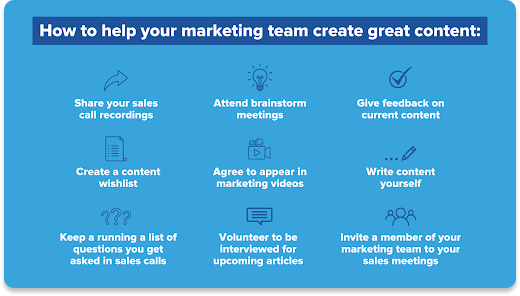Buyers today want to find the information themselves and reach out for help only when they’re ready — if at all.
According to research from Gartner, 33% of all buyers prefer a buying process that doesn’t include a salesperson at all (and that number climbs to 44% when it comes to Millennials).
Think about it. That means a good portion of your buyers don’t want to talk to your sales team at all. Even for those who do, they only want to do so on their terms. This means they will reach out when they’re ready. They’re not interested in old-school outbound sales techniques that rush their decision-making process.
Building a library of content
Today, your customers don’t want to speak to your sales team until they’re further down the funnel — and closer to a decision. Therefore, you need your marketing team to create content that can educate customers so they can move down the funnel and get to a point where they’re ready to reach out to a sales team member.
Yes, this is marketing’s job, but they can’t do it alone.
If you leave marketers in charge, you’ll often end up with content that misses the mark. No offense to marketers. The truth is simple: No one knows your customers better than the sales team.
So, how do you help marketing create content?

Using that content in the sales process
Inbound salespeople have to see themselves as educators first. This means that they share information to help prospects make the right decision.
In doing so, you completely change the nature of the sales process.
Let me explain.
Let me ask you a question: What percentage of the questions you’re going to hear on your next call are questions you’ve heard before?
If you’ve been selling for a while, it’s probably a pretty high percentage. You might know ahead of time a lot of the questions you’re going to get — and you’ve answered them so many times that you’ve got your delivery memorized.
Now, imagine if you could go into your next call with all of these questions answered. When your prospect’s most basic questions have all been addressed beforehand, you can speak about that prospect’s individual needs and concerns. Suddenly your sales process has become a lot more interesting and a lot less redundant.
At IMPACT, we teach our clients to use a technique called assignment selling.
Assignment selling is the process of sharing — or “assigning” — content ahead of a sales meeting so that the prospect’s basic questions are all answered ahead of time.
This goes beyond a “check out these materials if you have time” approach. We require our prospects to read or view specific content before a meeting. If they don’t, we cancel or reschedule the call.
It sounds antithetical to most sales reps, but here’s the thing: The more a prospect knows ahead of time, the more they know about whether your solution is right for them or not.
Good-fit prospects will move more quickly through the sales process; bad-fit prospects will opt out, saving you time that wouldn’t have resulted in a deal anyway (or, even worse, might have ended up with an unhappy and disgruntled customer).
Selling more by selling less
We all know what it feels like to be sold to. Whether it’s a cold call during dinner, a tone-deaf sales email, a LinkedIn prospecting message, or any other invasive outreach or pushy approach, we pull back when we’re pushed into a sales process we’re not ready for.
At the same time, we all love discovering new products and buying new things.
So, how do we match our sales process to the way customers buy today? By being helpful, not salesy. If we take the pressure out of the equation, everyone is more comfortable.
In a recent sales call, I had a prospect tell me something I’m not going to forget.
Now, it’s worth noting that what we sell is complex: An 18-month coaching and training program to help you master inbound sales and marketing. It takes a lot of learning for company leaders to fully understand their own struggles and how we can help them.
On this call, just as it was wrapping up, the CEO told our salesperson, “Thank you for educating us instead of selling us.”
This was music to my ears.
We were focused on their growth, not on our sale. In the end, they weren't a good fit for our services, but I know they left with a positive impression. And I’d bet they’d recommend us to their friends who might be better prospects. That's worth a lot more than pushing through a sale and ending up with an unhappy or difficult customer.
When we commit to educating our prospects, we provide them with the information they need to become our customers. We build trust and establish relationships. And when we get the sale, we’re much more likely to end up with a happy customer and a brand ambassador who helps us generate more revenue in the future.
